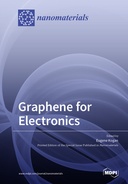Explore

Graphene is an allotrope of carbon consisting of a single layer of atoms arranged in a two-dimensional (2D) honeycomb lattice. Graphene's unique properties of thinness and conductivity have led to global research into its applications as a semiconductor. With the ability to well conduct electricity at room temperature, graphene semiconductors could easily be implemented into the existing semiconductor technologies and, in some cases, successfully compete with the traditional ones, such as silicon. This reprint presents very recent results in the physics of graphene, which can be important for applying the material in electronics.
This book is included in DOAB.
Why read this book? Have your say.
You must be logged in to comment.
Rights Information
Are you the author or publisher of this work? If so, you can claim it as yours by registering as an Unglue.it rights holder.Downloads
This work has been downloaded 79 times via unglue.it ebook links.
- 79 - pdf (CC BY) at Unglue.it.
Keywords
- angle-resolved photoemission
- augmented plane waves
- band structure
- borophene
- Bose-Einstein condensation
- circulating system
- conductive ink
- CVD graphene
- dephasing
- dipolar exitons
- Dirac fermions
- electric field
- electron scattering
- electronic transport in graphene
- first-principle
- GB distribution
- grain boundary (GB)
- grain size
- Graphene
- graphene nanosheets
- graphene solution
- image potential
- image-plane position
- image-potential states
- Inkjet printing
- ion-selective field-effect transistor
- Klein tunneling
- liquid conductor
- low-dimensional semimetals
- Mathematics & science
- mechanochemistry
- microfluidic channel
- n/a
- nanoscroll
- optical power
- Physics
- polycrystalline
- Printed electronics
- quantum Hall effect
- real-time monitoring
- relaxation time
- Scattering
- sheet resistance
- single-crystalline grain
- sodium ions
- superfluidity
- temperature
- tight-binding model
- transmission-line model measurement
- valence charge density
Links
DOI: 10.3390/books978-3-0365-6167-7Editions

